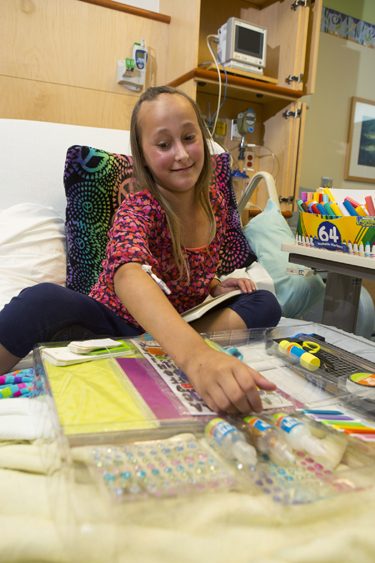Eight days after the pediatric liver transplant program at the Monroe Carell Jr. Children’s Hospital at Vanderbilt was launched, 10-year-old Aubree Vanzant received her liver.

Diagnosed on May 27 with autoimmune hepatitis, the Maryville resident underwent a 12-hour surgery to remove her grossly oversized organ to replace it with a healthy, deceased donor liver on June 25.
Now, two weeks post transplant, she is preparing to leave the hospital to recuperate in a nearby hotel.
Nikole Sellers, Aubree’s mother, said there have been a multitude of blessings throughout the entire journey, including having the director of the Vanderbilt Transplant Center as the lead surgeon on their case.
“I am so thankful for the entire team,” said Sellers. “I knew she was in good hands. We couldn’t get any better than that!”
No stranger to building nationally recognized liver transplant programs — he has three under his belt — Douglas Hanto, M.D., Ph.D., professor of Surgery and director of the Vanderbilt Transplant Center, said starting the pediatric program will allow children in the region with liver disease to receive world-class care close to home.
“We have a goal of identifying the Monroe Carell Jr. Children’s Hospital at Vanderbilt as a comprehensive transplant center,” said Hanto, who along with Department of Surgery Chair Seth Karp, M.D., will serve as the two pediatric liver transplant surgeons. “With the addition of the liver transplant program, our ability to care for some of the more complex pediatric medical conditions is greatly expanded.”
Children’s Hospital now offers liver, heart, kidney and stem cell transplantation.
Bringing a pediatric liver transplant service into the fold of a well established and successful transplant center, one that boasts outstanding outcomes, helps to highlight the expertise and support that already exists at Vanderbilt, Hanto said.
“The program we are starting is new, but our medical, surgical and transplant teams are very experienced. This is a very exciting time for us and we are looking forward to getting started.”
Hanto expects to integrate the newest innovative and technological solutions as the pediatric liver transplant program is unveiled, including:
• An immunocompromised host consult service for all pediatric transplants. Established by Infectious Diseases, it is designed to offer input into the care of patients whose immune systems are suppressed or impaired.
• Discussions about combined heart/liver transplants for a special subset of patients with congenital heart abnormalities, who as they age, may develop liver failure requiring the transplantation of both organs.
• The expansion of the care of patients with inborn errors of metabolism, rare genetic disorders in which the body cannot properly turn food into energy.
Lynette Gillis, M.D., assistant professor of Pediatrics, is the director of Pediatric Hepatology and Liver Transplantation at Children’s Hospital.
Adding a pediatric liver transplant program allows patients and families to continue in the familiar and supportive environment they have grown accustomed to with the liver medical team.
“We continue to have a very large and active pediatric liver clinic patient population,” Gillis said. “Families travel a long distance to come here, some driving three-four hours. Having a regional center will make a huge difference for them, especially in terms of family and community support.”
Gillis’ clinic has roughly 1,000 patients visits annually, with 10-15 patients requiring liver transplantation every year.
Hanto anticipates pediatric liver transplant volumes of 6-7 in the first year, with the goal of eventually performing 15-20 per year, making it the largest program in the state.
Sellers is grateful that the program opened when it did. In a two-week period, Aubree went from being a relatively healthy elementary school student to requiring a life-saving liver transplant.
“For the first week of her diagnosis, I did nothing but cry,” she said. “Throughout this entire process, Aubree has been so brave and strong.
“During my weakest moments she turned to me and said that I needed to stop being a crybaby and to put my big girl panties on,” Sellers chuckled. “She may have been really, really sick, but that personality of hers always shined through it all.”












